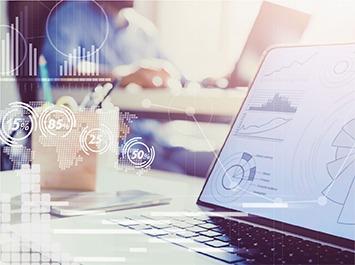
Big Data and Business Intelligence, or retail must-have
12 May 2020
The retail sector generates and collects gigantic amounts of data. Each POS handles from a few to tens of thousands of transactions a day, each visit to the e-shop website is a dozen or so thousands of bytes of customer data, and each interaction with the customer in social media is a potential beginning or effect of the sales process. Countless warehousing and logistics operations, payments, CCTV camera records, ERP, CRM, mobile applications – this calls for associating these information with each other and using them to build a competitive advantage. This will enable e.g. better targeting of advertisements, improvement of service processes, effective involvement of customers in thoughtful sales scenarios or finally identification of places of cost optimization.
Big Data – success hidden in data
The use of Big Data by retail chains entails a number of benefits. The following are among them:
- collecting and processing data about customers, their behaviour, purchasing preferences and segmenting this information in order to prepare effective marketing strategies,
- price optimization based on current and forecast trends in popularity of brands and product groups in connection with customer data, their location, purchasing preferences and data on prices offered by competitors,
- ensuring an adequate level of inventory through dynamic supply chain management based on the expected volume of sales of particular groups of goods or SKU products over a specific time period,
- improving the quality of service by collecting and analysing customer feedback in traditional channels and social media,
- optimization of the distribution of goods on the shelves by collecting information from cameras and motion sensors and modeling them in the form of templates of customer behavior in the store.
How to accurately predict consumer behaviour? How to guarantee perfect customer service? These questions are key issues for all professionals who are not only involved in retail trade. Today I would like to present two tools that will help to obtain answers to these and many other questions and efficiently support the whole retail industry.
Microsoft PowerBI
One of them is PowerBI – a solution provided by Microsoft, a leader among providers of IT tools in this segment, which in 2019, according to Gartner’s analysis, further strengthened its position. Euvic Group works closely with Microsoft at GOLD partner level. It is also proud of cooperation with Microsoft’s MVP (Most Valuable Professional) in the “Data Platform” area.
Tools built on the Microsoft PowerBI platform enable complete integration and validation of data from different sources (systems, devices, files). They can also transform this data into information about multidimensional contexts (time, geographical, behavioural, product, business). Using convenient visualizations and automatic notifications available within the PowerBI platform, managers can launch and manage business projects to achieve the business benefits described above.
The important fact is that operational managers can carry out their tasks using more detailed information presented on interactive dashboards and reports allowing to filter information and change the context of presented information.
Business development managers can build dashboards containing aggregated, cross-cutting information about the brand’s locations, with the additional possibility of including competition data (if available in the required degree of detail).
PowerBI is an IT tool operating in modern SaaS architecture (as a service in the cloud). Placing it in a secure Microsoft Azure location protects it from unauthorized access and loss of data. Euvic IT company employs specialists who, thanks to their knowledge and experience, can advise which of the available variants of services will be the most optimal for a given organization or industry in general. The entire Euvic Group, on the other hand, employs experienced programmers who have been building Data Warehouse systems on the PowerBI and SQL/BI platforms for many years on a daily basis so that the managers can successfully achieve all their business goals.
Netizens MovStat
The second noteworthy solution I would like to mention today is MovStat – an original product made by programmers and engineers from Netizens. The MovStat system analyzes anonymous traffic data of people in public places. The solution is based on video streams from the cameras and continuously converts the data into numbers. The data then takes the form of statistics, in the form of intuitive and pleasing to the eye visualizations.
“MovStat is making its contribution to the digital revolution in retail. Store managers can present inter alia. the main shopping paths of the customers, the most popular zones and products located in them, customer interaction with the display and goods or analysis of the queues forming. The added value of this system is also a quick preview of the conversion for both people in front of and inside the store. With such precise information, managers – after summarizing it – can better plan the store’s infrastructure, improve staff management, verify the quality of customer service or respond faster to emerging challenges,” Paweł Herman, International Business Development Manager at Netizens, explains.
Summary
Both tools have a number of advantages. Regardless of which of them we choose, we should remember that only proper use of Big Data and Business Intelligence will allow us to conduct our sales activities in a more thoughtful and orderly manner. And this will certainly have a positive impact on the growth of our profits. BI and BD are not only the answer to the needs of modern business. These tools are a real recipe for business success.
The author of the article is Bartłomiej Łatka, an expert on retail and logistics.
back